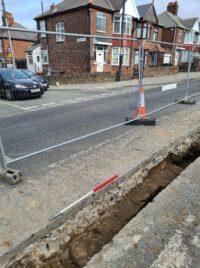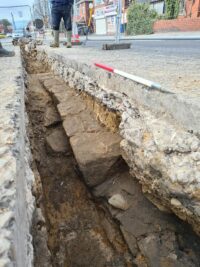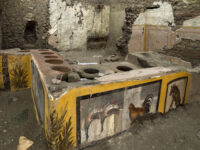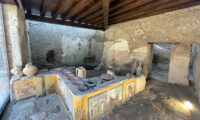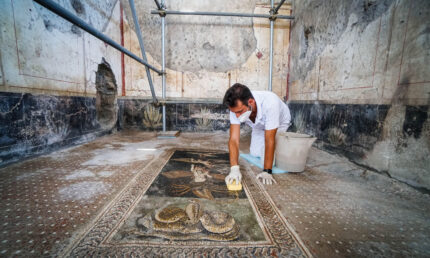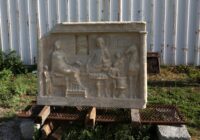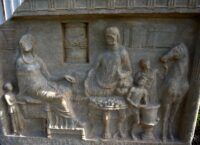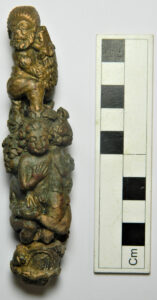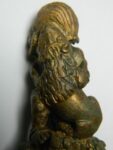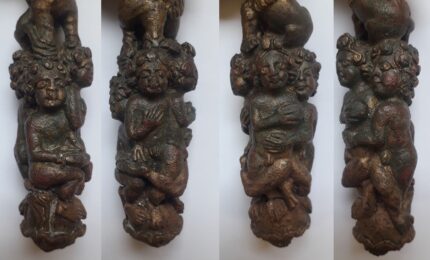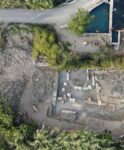 Excavations this summer in San Casciano dei Bagni, a picturesque Tuscan hilltop town 40 miles southeast of Siena renowned for its hot springs, have discovered archaeological treasure including hundreds of gold, silver, orichalcus and bronze coins, a bronze putto, a marble relief of a head of a bull, five bronze votive figurines, miniature lamps, a bronze foil belt and other religious offerings that mark the baths as a uniquely rich religious sanctuary beyond its importance as a thermal resort.
Excavations this summer in San Casciano dei Bagni, a picturesque Tuscan hilltop town 40 miles southeast of Siena renowned for its hot springs, have discovered archaeological treasure including hundreds of gold, silver, orichalcus and bronze coins, a bronze putto, a marble relief of a head of a bull, five bronze votive figurines, miniature lamps, a bronze foil belt and other religious offerings that mark the baths as a uniquely rich religious sanctuary beyond its importance as a thermal resort.
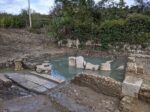 The perpetually 42°C (107.6°F) hot springs at San Casciano dei Bagni have been in continuous use since the Etruscans occupied the area. The thermal pools are used as an open-air bath adjacent to the ruins of the Roman spa built there under Augustus, but centuries of water and hot mud have taken their toll on the archaeological remains and complicate management of the ancient material as well as the modern spa facilities.
The perpetually 42°C (107.6°F) hot springs at San Casciano dei Bagni have been in continuous use since the Etruscans occupied the area. The thermal pools are used as an open-air bath adjacent to the ruins of the Roman spa built there under Augustus, but centuries of water and hot mud have taken their toll on the archaeological remains and complicate management of the ancient material as well as the modern spa facilities.
Last year’s excavations, carried out between July and October under COVID health protocols, explored an abandoned wilderness a 20 meters south of the pools. They unearthed a section of a multi-layer Roman sanctuary built in the Augustan era that contained three altars dedicated to Apollo, Isis and Fortuna Primigenia respectively, and a marble statue of Hygieia. Inscriptions invoke Apollo in his role as god of healing. A wall of large, well-cut blocks underneath the Augustan-era sanctuary suggests it was built over an even more ancient sacred place dating at least as far back as the Hellenistic era, and possibly of even earlier Etruscan origin.
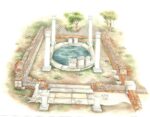 The sanctuary was heavily damaged in a fire in the 1st century and was rebuilt and expanded. The altars were deposited on the edge of the large bath around the end of the 2nd century. The sanctuary was restored again in the early 4th century and a few small annexes added, but by the end of the century the ancient sanctuary was destroyed. Columns and altars were laid horizontally over votive offerings, including the statuette of Hygieia. This was likely related to the Christianization of the area.
The sanctuary was heavily damaged in a fire in the 1st century and was rebuilt and expanded. The altars were deposited on the edge of the large bath around the end of the 2nd century. The sanctuary was restored again in the early 4th century and a few small annexes added, but by the end of the century the ancient sanctuary was destroyed. Columns and altars were laid horizontally over votive offerings, including the statuette of Hygieia. This was likely related to the Christianization of the area.
 The finds made this year were deposits left by worshippers at the site. Archaeologists believe the quality and quantity of offerings point to the sanctuary having been of great regional importance, a Romanized expression of a far more ancient rite of veneration of the hot spring where the faithful could have direct experience of the deity by bathing.
The finds made this year were deposits left by worshippers at the site. Archaeologists believe the quality and quantity of offerings point to the sanctuary having been of great regional importance, a Romanized expression of a far more ancient rite of veneration of the hot spring where the faithful could have direct experience of the deity by bathing.
The coins were minted in the reigns of Augustus, the Flavian emperors,  Trajan, Hadrian and Marcus Aurelius. The bull was carved into one of the blocks of the pool. Created by a master craftsman, the putto wears the sacred bulla around his neck and has an ancient inscription carved on his right thigh dedicating the offering.
Trajan, Hadrian and Marcus Aurelius. The bull was carved into one of the blocks of the pool. Created by a master craftsman, the putto wears the sacred bulla around his neck and has an ancient inscription carved on his right thigh dedicating the offering.
Perhaps the most unexpected surprise of the dig season was found on the surface of the sacred basin. It is covered in “footprints” carved into the 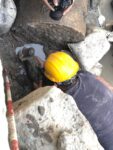 travertine. Traces of lead and silver were found inside of them, so when they were new, they would have shimmered silver-white in the water. The footprints are of varied sizes — adults, youths, children — and were carved as if they’d been left by sandaled feet. There are also bull hooves and ears with the human tootsies. This unusual devotional iconography may be linked to Isis and Serapis. It’s also possible the faithful “walked in the footsteps” of the gods in the bath basin as a means to secure their good health.
travertine. Traces of lead and silver were found inside of them, so when they were new, they would have shimmered silver-white in the water. The footprints are of varied sizes — adults, youths, children — and were carved as if they’d been left by sandaled feet. There are also bull hooves and ears with the human tootsies. This unusual devotional iconography may be linked to Isis and Serapis. It’s also possible the faithful “walked in the footsteps” of the gods in the bath basin as a means to secure their good health.
The excavations of the last four years are part of San Casciano dei Bagni’s Roman Baths Project which aims to create an open-air, accessible 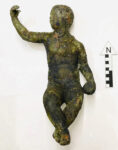 archaeological park with on-site laboratory space at the ancient bath site. The first priority is repairing the outflow of the thermal waters both to preserve the archaeological remains and, ideally, to restore the thermal function of the original Roman elements. There’s a lot of mud (and whatever has been trapped in it for thousands of years) to get through before that can happen.
archaeological park with on-site laboratory space at the ancient bath site. The first priority is repairing the outflow of the thermal waters both to preserve the archaeological remains and, ideally, to restore the thermal function of the original Roman elements. There’s a lot of mud (and whatever has been trapped in it for thousands of years) to get through before that can happen.
